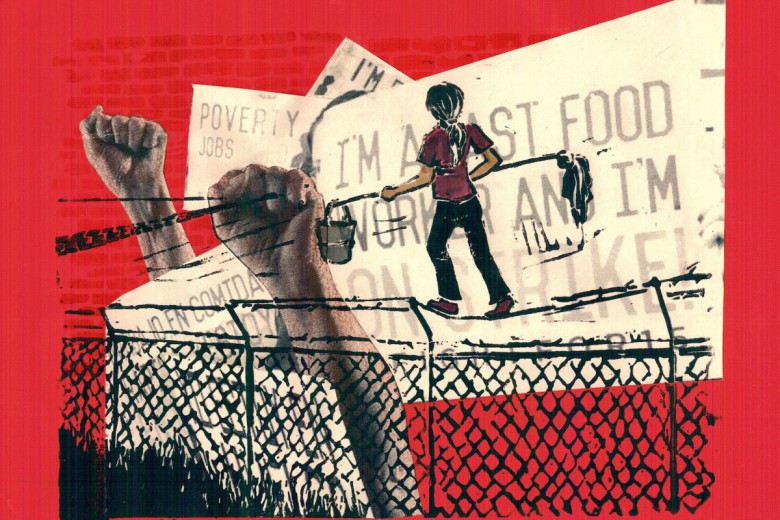
If you’re among those who regularly shell out the equivalent of office rent at coffee shops to get a bit of work done, it’s easy to imagine a typical scene at The Common, a café in Toronto’s west end. Located in MP Andrew Cash’s Davenport riding, The Common was an apt venue for the NDP politico’s launch of his Urban Worker Strategy campaign in May. Working in a flexible labour market brings challenges bigger than snagging a spot to plug in your laptop, which is why Cash is presenting a more comprehensive response.
Cash’s approach – working through the state to secure a better deal for precarious workers – is at odds with neoliberalism’s preferred qualities: high self-reliance and low expectations from employers and the state. The Urban Worker campaign zooms in on policy, a mostly invisible yet materially significant social frame that enables or constrains our livelihoods.
This fall, Cash will move his Urban Worker Strategy from The Common café to the House of Commons, where he’ll pitch it as a private member’s bill. The bill proposes a sweeping suite of overdue federal policies that respond to the plight of temps, freelancers, interns, part-timers and other flexworkers who flit from gig to gig, shift to shift, contract to contract, with no guarantee of income or future work, let alone access to benefits or pensions. Says Cash, “Today’s reality of work has fundamentally changed, yet our policies remain stuck in the past.”
It’s no coincidence that the parliamentarian leading this initiative is himself a cultural worker. A musician for 30 years, Cash has long had his ear to the shaky ground of precarious work: volatile schedules, overwork, underpayment, a lack of health benefits, and zero job security. With his Urban Worker bill, Cash aims to draw connections among workers across the precarious labour market, from web designers to office cleaners, artists to taxi drivers. “As an artist, prior to politics, I always felt like I had common issues with the taxi driver who was driving me to the gig,” he says by way of example. “Neither of us had access to benefits. If I was sick, I couldn’t get paid, and if he was sick, he wasn’t going to get paid.” Even so, one of the challenges likely to dog the Urban Worker Strategy will be demonstrating that it can create a safety net for more than just the downtown creative class.
A precariat think tank
Commentators use the tag “precariat” to refer to the swelling population of those in precarious work, which has grown amid changing conditions of production, deindustrialization, outsourcing, declining unionization, and a shift from full-time salaried work to flexible arrangements with weak protections. While lean businesses feast on a buffet of options beyond costly full-time employees, the consequence is a deepening insecurity for everyone else.

Such conditions are increasingly well-known, thanks in no small part to the efforts of what labour advocate Josh Eidelson calls “alt-labour”: groups that organize workers who, for legal or other reasons, can’t join unions. Alt-labour uses direct action, legal contests, and other tactics to improve constituents’ working conditions. Worker centres – member-based advocacy and activist organizations for low-wage and immigrant workers – have long been alt-labour’s best-known examples, but as precarity creeps across the value chain, alt-labour has sprung up in creative economy quarters, too: the Freelancers Union in New York City has prepared a Freelancer Payment Protection Act (under review at the state level); youth are waging battles against unpaid internships and pressing for the enforcement of existing regulations; artists in Italy are collaborating with lawyers to creatively leverage constitutional provisions to protect occupied cultural spaces from privatization; and co-working spaces in Ontario now offer benefits plans to members.
And so Cash is not a lone traveller on the Urban Worker campaign trail, which has been bolstered by recent research. Cash cites a United Way-sponsored report revealing that “barely half” of those in the Greater Toronto Area have permanent, full-time jobs that offer benefits and a semblance of security. “We haven’t met that stark statistic with the requisite amount of outrage and shock,” he says. The report also notes that, in two decades, precarious employment has almost doubled. Another major report, released in 2012 by the Law Commission of Ontario, confirms that women, racialized people, and recent immigrants are more likely to be in precarious work.
Alt-labour, community-based organizations, unions, and their researcher allies are leading the work of documenting the scope of precarious employment. What makes this research from below especially vital to the labour policy process is that it not only documents precarity but also proposes measures for mitigating its worst effects. For many workers in unstable employment, policy is one of the few mechanisms for improving their social and economic conditions. Labour groups like the Alliance of Canadian Cinema, Television and Radio Artists, the Canadian Intern Association, and the Workers’ Action Centre are among the incubators of policy recommendations that underlie – or should underlie – the Urban Worker Strategy.
Policy mash-up
Cash calls the Urban Worker bill a framework bill because it establishes some basic building blocks for confronting key challenges. Still, its pillars are wide-ranging.
First, it addresses expanding access to employment insurance (EI). Currently, only 40 per cent of unemployed workers in Canada qualify for EI, and workers must wait two weeks or more to receive benefits, which pushes people into “crappier jobs,” says Deena Ladd, coordinator of the Workers’ Action Centre. Improving EI access is critical, she says. “That is the only safety net that a lot of workers have.”
The second component of the bill is taxation reform for the self-employed that would, for example, introduce income tax averaging for workers whose earnings fluctuate year to year.
The third piece is to expand access to pensions for non-standard workers.
And the fourth is a grab bag: enforcing labour laws for temp agency workers; strengthening enforcement of rules around internships; extending supplementary health benefits to the precariously employed; and working with provinces to prevent job misclassification, the legal sleight of hand wherein employers hire workers as independent contractors to evade employment standards.
This patchwork of policies could take the edge off precarity for a range of workers. “One of the powerful elements to this issue is its potential to build bridges between groups of workers who traditionally have not spoken to each other,” Cash says. Although he recognizes the real differences in the lives of those who may choose to pursue uncertain careers in culture and those who have no choice but to take temp jobs, Cash says that precarious work “affects people right across the social class spectrum.” Wage theft, misclassification, and income insecurity are indeed problems for workers across the class spectrum.
Workers who can’t access a traditional employment relationship don’t neatly fit conventional labour organizing models, which is why policy is a strategic site of intervention. Instead of designing policy from above, the Urban Worker bill draws on proposals instigated from below by unions and alt-labour. “It’s not like we are trying to reinvent the wheel,” admits Cash. “We are trying to … package it.” Stitching policy together in this way potentially unites worker organizations that often operate in silos. Consultations on the bill – which included “urban worker forums” in Cash’s riding – involved, among others, United Steelworkers, ACTRA, iTaxi (the taxi workers’ association), and the Workers’ Action Centre.
On the face of it, such efforts double as an opportunity to practically reconsider the perennially fraught relationship between the NDP and the labour movement and also serve as an opportunity to test possible relations of solidarity within an expanded labour movement. The bill’s development process gives workers and their organizations agency as policy architects. What’s more, it enables cultural workers to contribute to policy development that extends beyond their immediate interests. “It’s nice to be able to allow our members, who have a unique ability to grab attention, a chance to participate in something like this, which might benefit a broader range of workers,” says Marit Stiles, director of public policy and communication for ACTRA, an early Urban Worker Strategy supporter.
The bill holds promise to amplify a pan-sectoral conversation about precarious work. Yet Cash’s pitch comes with its own problems, some of which can be approached through the bill’s banner phrase, “urban worker.”
Precarious folksonomy
Finding language to unite disparate working people is necessary, but risky. Driven by a desire to identify what binds, the label “urban worker” may too quickly bypass what divides. Cash represents a downtown riding, and his campaign may have a more delimited boundary than he cares to admit. The urban worker label risks sidelining, for example, challenges faced by suburban workers (many of whom perform the services on which the core depends but who are pushed to the outskirts) and those in rural areas, such as migrant farm workers.
Divisions based on class, race, status, and place are decisive factors of power shaping just how precarious a worker’s life and labour may be. And the bill’s gaps reveal its class bias. A stance on minimum wage, for instance – currently the focus of community coalition organizing in Ontario – is missing. The bill also has jurisdictional issues: the Urban Worker bill will be tabled federally, but changes must be made at the provincial level to provide workers with enforceable protections. As it progresses, the Urban Worker Strategy will need to be an integrated federal-provincial operation.
Another way to tackle the diversity of precarious employment, suggests Ladd, would be through a “decent jobs” lens. “It doesn’t sound as sexy as an ‘urban worker’ kind of framework,” she says, “but I think a lot of people wouldn’t mind a decent job.” And a bold proposal, also absent from the Urban Worker bill but which has precedent in Canadian policy discourse, is the call for a guaranteed annual minimum income.
Imagined beyond a framework bill, a strategy along the lines that Cash is pursuing will need to be built upon a long history of legislative research and policy proposals forwarded by activists. And, as Ladd points out, it will need to link up to a host of issues related to precarity: immigration, housing, training and education, labour market regulation, human rights, and health and safety. The Urban Worker Strategy’s sticking points turn on the very real disparities that exist between workers. However, that may be where the potential of the bill, or, more precisely, the campaign around it, lies: if Cash can get cultural workers to speak to issues also faced by marginalized workers, then the experiences these workers do have in common could be the basis for larger, more far-reaching change.
Another report is possible!
Writing a compelling policy recommendation is one thing; it’s another to have the capacity to impose it from below. To be more than an online petition with 248 signatures (the count at the time of writing), the Urban Worker Strategy must not only name trends but also mobilize people, and gathering mobile temps or dispersed freelancers is difficult. Policy can help to do that work, but it’s no substitute for organizing. And when it comes to organizing, a key question is how to build solidarities and shared campaigns around precarious work without erasing the power differentials and social inequities that divide labour market experiences, particularly those of race and class. “This is the sort of thing we all have to grapple with,” Ladd says. “Because if we don’t, what’s going to happen is that those who have the decent-paying jobs are going to lose them and those who have the crappy, marginalized jobs are going to continue to be marginalized – and there are going to be no points of connection.”
Cash stresses the points of connection. “I don’t want to downplay those differences,” he says, “but at the same time, I don’t want to give in and say therefore there’s really no common ground, because there is common ground.” Whatever the outcome in Ottawa, the Urban Worker Strategy is scaling up the conversation about precarious labour in the overhyped creative industries and the service sectors upon which they depend. The bill is vast and currently light on detail. But a benefit of a sweeping policy proposal is that it pushes us to imagine what’s possible. And what’s possible now is more than another commission or report confirming what research from below has established: that conditions of work are declining and the prevailing policy framework is insufficient for mitigating flexworkers’ precarity.



_780_520_90_s_c1.jpg)


